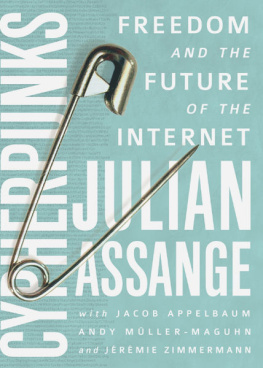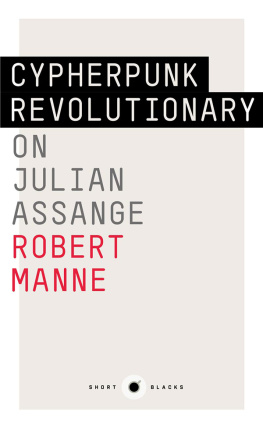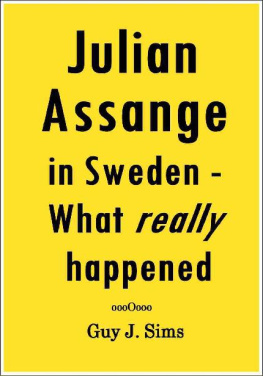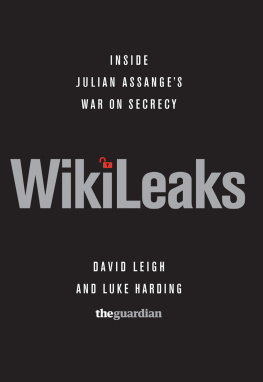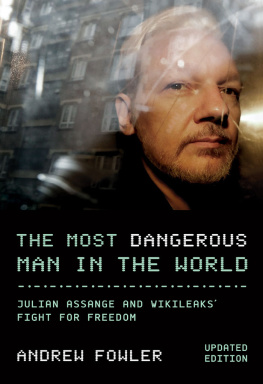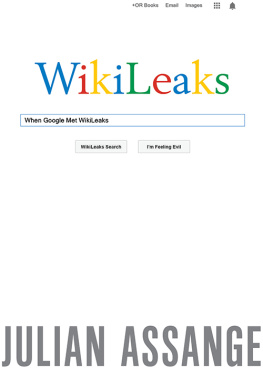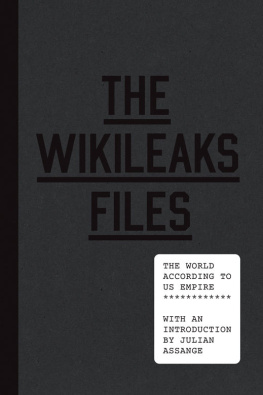Julian Assange - The WikiLeaks Files: The World According to US Empire
Here you can read online Julian Assange - The WikiLeaks Files: The World According to US Empire full text of the book (entire story) in english for free. Download pdf and epub, get meaning, cover and reviews about this ebook. year: 2015, publisher: Random House Inc;Verso, genre: Politics. Description of the work, (preface) as well as reviews are available. Best literature library LitArk.com created for fans of good reading and offers a wide selection of genres:
Romance novel
Science fiction
Adventure
Detective
Science
History
Home and family
Prose
Art
Politics
Computer
Non-fiction
Religion
Business
Children
Humor
Choose a favorite category and find really read worthwhile books. Enjoy immersion in the world of imagination, feel the emotions of the characters or learn something new for yourself, make an fascinating discovery.
- Book:The WikiLeaks Files: The World According to US Empire
- Author:
- Publisher:Random House Inc;Verso
- Genre:
- Year:2015
- Rating:5 / 5
- Favourites:Add to favourites
- Your mark:
- 100
- 1
- 2
- 3
- 4
- 5
The WikiLeaks Files: The World According to US Empire: summary, description and annotation
We offer to read an annotation, description, summary or preface (depends on what the author of the book "The WikiLeaks Files: The World According to US Empire" wrote himself). If you haven't found the necessary information about the book — write in the comments, we will try to find it.
The WikiLeaks Files: The World According to US Empire — read online for free the complete book (whole text) full work
Below is the text of the book, divided by pages. System saving the place of the last page read, allows you to conveniently read the book "The WikiLeaks Files: The World According to US Empire" online for free, without having to search again every time where you left off. Put a bookmark, and you can go to the page where you finished reading at any time.
Font size:
Interval:
Bookmark:
to US Empire
Julian Assange
First published by Verso 2015
The collection Verso 2015
Contributions The contributors 2015
Introduction Julian Assange 2015
All rights reserved
The moral rights of the authors have been asserted
1 3 5 7 9 10 8 6 4 2
Verso
UK: 6 Meard Street, London W1F 0EG
US: 20 Jay Street, Suite 1010, Brooklyn, NY 11201
www.versobooks.com
Verso is the imprint of New Left Books
ISBN-13: 978-1-78168-874-8 (HB)
ISBN-13: 978-1-78478-271-9 (EXPORT)
eISBN-13: 978-1-78168-875-5 (UK)
eISBN-13: 978-1-78168-944-8 (US)
British Library Cataloguing in Publication Data
A catalogue record for this book is available from the British Library
Library of Congress Cataloging-in-Publication Data
A catalog record for this book is available from the Library of Congress
Typeset in Sabon by MJ & N Gavan, Truro, Cornwall
Printed in the US by Maple Press
WikiLeaks and Empire
One day, a monk and two novices found a heavy stone in their path. We will throw it away, said the novices. But before they could do so, the monk took his ax and cleaved the stone in half. After seeking his approval, the novices then threw the halves away. Why did you cleave the stone only to have us throw it away? they asked. The monk pointed to the distance the half stones had traveled. Growing excited, one of the novices took the monks ax and rushed to where one half of the stone had landed. Cleaving it, he threw the quarter, whereupon the other novice grabbed the ax from him and rushed after it. He too cleaved the stone fragment and threw it afield. The novices continued on in this fashion, laughing and gasping, until the halves were so small they traveled not at all and drifted into their eyes like dust. The novices blinked in bewilderment. Every stone has its size, said the monk.
At the time of writing, WikiLeaks has published 2,325,961 diplomatic cables and other US State Department records, comprising some two billion words. This stupendous and seemingly insurmountable body of internal state literature, which if printed would amount to some 30,000 volumes, represents something new. Like the State Department, it cannot be grasped without breaking it open and considering its parts. But to randomly pick up isolated diplomatic records that intersect with known entities and disputes, as some daily newspapers have done, is to miss the empire for its cables.
Each corpus has its size.
To obtain the right level of abstraction, one which considers the relationships between most of the cables for a region or country rather than considering cables in isolation, a more scholarly approach is needed. This approach is so natural that it seems odd that it has not been tried before.
The study of empires has long been the study of their communications. Carved into stone or inked into parchment, empires from Babylon to the Ming dynasty left records of the organizational center communicating with its peripheries. However, by the 1950s students of historical empires realized that somehow the communications medium was the empire. Its methods for organizing the inscription, transportation, indexing and storage of its communications, and for designating who was authorized to read and write them, in a real sense constituted the empire. When the methods an empire used to communicate changed, the empire also changed.
Speech has a short temporal range, but stone has a long one. Some writing methods, such as engraving into stone, suited the transmission of compressed institutional rules that needed to be safely communicated into future months and years. But these methods did not allow for rapidly unfolding events, or for official nuance or discretion: they were set in stone. To address the gaps, empires with slow writing systems still had to rely heavily on humanitys oldest and yet most ephemeral communications medium: oral conventions, speech.
Other methods, such as papyrus, were light and fast to create, but fragile. Such communications materials had the advantage of being easy to construct and transport, unifying occupied regions through rapid information flow that in turn could feed a reactive central management. Such a well-connected center could integrate the streams of intelligence coming in and swiftly project its resulting decisions outwards, albeit with resulting tendencies toward short-termism and micromanagement. While a sea, desert, or mountain could be crossed or bypassed at some expense, and energy resources discovered or stolen, the ability to project an empires desires, structure, and knowledge across space and time forms an absolute boundary to its existence.
Cultures and economies communicate using all manner of techniques across the regions and years of their existence, from the evolution of jokes shared virally between friends to the diffusion of prices across trade routes. This does not by itself make an empire. The structured attempt at managing an extended cultural and economic system using communications is the hallmark of empire. And it is the records of these communications, never intended to be dissected, and so especially vulnerable to dissection, that form the basis for understanding the nature of the worlds sole remaining empire.
ANATOMY OF THE US EMPIRE
And where is this empire?
Each working day, 71,000 people across 191 countries representing twenty-seven different US government agencies wake and make their way past flags, steel fences, and armed guards into one of the 276 fortified buildings that comprise the 169 embassies and other missions of the US Department of State. They are joined in their march by representatives and operatives from twenty-seven other US government departments and agencies, including the Central Intelligence Agency, the National Security Agency, the Federal Bureau of Investigation, and the various branches of the US military.
Inside each embassy is an ambassador who is usually close to domestic US political, business or intelligence power; career diplomats who specialize in the politics, economy, and public diplomacy of their host state; managers, researchers, military
Above them, radio and satellite antennas scrape the air, some reaching back home to receive or disgorge diplomatic and CIA cables, some to relay the communications of US military ships and planes, others emplaced by the National Security Agency in order to mass-intercept the mobile phones and other wireless traffic of the host population.
The US diplomatic service dates back to the revolution, but it was in the postWorld War II environment that the modern State Department came to be. Its origins coincided with the appointment of Henry Kissinger as secretary of state, in 1973. Kissingers appointment was unusual in several respects. Kissinger did not just head up the State Department; he was also concurrently appointed national security advisor, facilitating a tighter integration between the foreign relations and military and intelligence arms of the US government. While the State Department had long had a cable system, the appointment of Kissinger led to logistical changes in how cables were written, indexed, and stored. For the first time, the bulk of cables were transmitted electronically. This period of major innovation is still present in the way the department operates today.
The US Department of State is unique among the formal bureaucracies of the United States. Other agencies aspire to administrate one function or another, but the State Department represents, and even houses, all major elements of US national power. It provides cover for the CIA, buildings for the NSA mass-interception equipment, office space and communications facilities for the FBI, the military, and other government agencies, and staff to act as sales agents and political advisors for the largest US corporations.
Font size:
Interval:
Bookmark:
Similar books «The WikiLeaks Files: The World According to US Empire»
Look at similar books to The WikiLeaks Files: The World According to US Empire. We have selected literature similar in name and meaning in the hope of providing readers with more options to find new, interesting, not yet read works.
Discussion, reviews of the book The WikiLeaks Files: The World According to US Empire and just readers' own opinions. Leave your comments, write what you think about the work, its meaning or the main characters. Specify what exactly you liked and what you didn't like, and why you think so.




